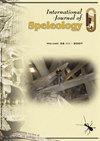洞穴主题的低影响取样——调和科学研究与洞穴保护
IF 1.3
4区 地球科学
Q3 GEOSCIENCES, MULTIDISCIPLINARY
引用次数: 0
摘要
洞穴化石作为重要的古气候档案越来越受到重视,然而从洞穴中取出样本可能会以自然遗产为代价,影响脆弱的环境,修复机制有限。保护洞穴环境是科学家的一项重要责任,考虑到这一点,我们正在努力开发和实施技术,使我们能够以最小的影响提取有价值的科学数据。在这项研究中,我们展示了在塔斯马尼亚南部和西澳大利亚西南部的洞穴中进行低影响的勘测测年的效用,作为去除石笋进行古气候重建的先驱。从落石的底部和顶端分别提取方解石的小薄片,并使用U-Th技术测定年代。我们专门针对那些自然掉落的石笋或之前被人类干扰破坏的石笋,以进一步减少我们对洞穴的影响。这种方法提供了每个石笋的最大和最小年龄限制以及生长频率的宝贵信息,而无需从洞穴中取出整个样本。根据侦察年龄选择最合适的样本进行分析,大大减少了从洞穴中取出的洞穴材料的数量,以确定所需的过去时间间隔,减轻了研究的影响。此外,侦察年龄数据使我们能够建立洞穴洞穴年龄档案,以供将来的科学研究,并提供关于洞穴发展的年龄和性质的信息,对洞穴管理和其他研究有用。为了评估这种方法的准确性,我们将侦察年龄与从洞穴中取出的少量石笋的详细年龄评估结果进行了比较。我们发现这种方法是有效的,并使我们成功地确定了几种适合我们的科学目标的石笋。本文章由计算机程序翻译,如有差异,请以英文原文为准。
Low impact sampling of speleothems – reconciling scientific study with cave conservation
Speleothems are increasingly valued as important paleoclimate archives and yet the removal of samples from caves can come at a cost to natural heritage, impacting delicate environments with limited mechanisms for repair. Conservation of cave environments is a key responsibility for scientists and, with this in mind, we are working to develop and implement techniques that allow us to extract valuable scientific data, with minimal impact. In this study, we demonstrate the utility of low-impact reconnaissance dating surveys on caves in southern Tasmania and southwest Western Australia as a precursor to the removal of stalagmites for paleoclimate reconstruction. Small flakes of calcite were discretely extracted from the base and tip of fallen stalagmites and dated using U-Th techniques. We specifically targeted stalagmites that have naturally fallen or been previously broken by human interference, to further reduce our impact on the caves. This approach provides maximum and minimum age constraints for each stalagmite and valuable information of growth frequencies without the need to remove whole samples from the cave. Selecting the most appropriate samples to analyze based on reconnaissance ages greatly reduces the quantity of speleothem material to be removed from a cave to locate a desired interval of past time, mitigating the impacts of the research. Moreover, the reconnaissance age data enable us to build an archive of speleothem ages from the cave for future scientific research and to provide information on the age and nature of cave development, useful for cave management purposes and other studies. To assess the accuracy of this method we compared the reconnaissance age with the results of a detailed age evaluation on a small number of stalagmites removed from the caves. We have found this method to be effective and has allowed us to successfully identify several stalagmites suitable for our scientific objectives.
求助全文
通过发布文献求助,成功后即可免费获取论文全文。
去求助
来源期刊

International Journal of Speleology
地学-地球科学综合
CiteScore
3.10
自引率
23.10%
发文量
12
审稿时长
>12 weeks
期刊介绍:
The International Journal of Speleology has the aim to get cave and karst science known to an increasing number of scientists and scholars. The journal therefore offers the opportunity to all scientists working in and on karst to publish their original research articles or their review papers in an open access, high quality peer reviewed scientific journal at no cost. The journal offers the authors online first, open access, a free PDF of their article, and a wide range of abstracting and indexing services.
 求助内容:
求助内容: 应助结果提醒方式:
应助结果提醒方式:


